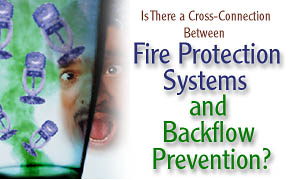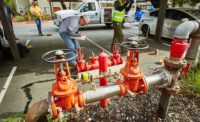
Issue: 10/02
There has been a significant amount of controversy over the last decade as to whether backflow protection should be provided on fire protection systems. Not only is there controversy over whether or not fire protection systems should be provided with backflow protection, but there is also controversy over the type of backflow prevention assembly that should be provided on the different types of fire protection systems.
There are four basic types of automatic fire sprinkler systems. They consist of wet-pipe, dry-pipe, pre-action and deluge systems. The basic system components of each sprinkler system consist of the water supply, both aboveground and underground piping, check and control valves, a fire department connection, sprinklers, inspectors test connections, and the hanger and support components for the system.
Wet-Pipe Sprinkler Systems
The wet-pipe system is the most common, reliable and economical of the sprinkler systems, and it is used in the majority of the sprinklered facilities of today. The majority of the wet-pipe fire sprinkler systems installed in these industrial and commercial facilities utilize black steel piping. This tends to generate water quality issues, as the water becomes stagnant in the piping system, allowing the chlorine residual to dissolve and the heavy metals from the pipe to leach into the water. Most wet-pipe sprinkler systems, both new and existing, have a check valve that is designed to prevent the reverse flow of water; however, this check valve is typically a non-testable device and is not considered a backflow prevention assembly.Based on the majority of the plumbing codes and recognized industry standards, some form of cross-connection control is required for wet-pipe fire sprinkler systems. The type and level of protection required is based upon the type of hazards present within the sprinkler system. If the wet-pipe sprinkler system utilizes a form of antifreeze solution, corrosion inhibitor or chemical fire suppression agent, the system is typically classified as having a "high" hazard potential and would require the use of a reduced pressure principle backflow prevention assembly. However, if the wet-pipe sprinkler system does not contain any chemical additives, and the fire department connection is a minimum distance from a non-potable water supply source (typically 1,700 feet), then the wet-pipe sprinkler system is typically classified as a "low" hazard system, requiring a double check backflow prevention assembly.
The intent behind the 1,700-foot distance between the fire department connection and the non-potable water supply is that there is potential for the fire department to pump the non-potable water back into the public drinking water supply. We must acknowledge that when a sprinkler system is provided with a fire department connection, there must be a check valve on the public water supply line to the sprinkler system to be compliant with the sprinkler design standards. Granted, this check valve is not a backflow preventer, but it will significantly reduce the risk of non-potable water being back-pressurized into the public water supply. The engineer must evaluate the risk of that fire department connection when it is less than 1,700 feet from a non-potable water supply and cannot automatically assume that a reduced pressure principle backflow prevention assembly is the best method of protection.
Reduced Pressure Principle Backflow Prevention Assemblies
It is acknowledged that a reduced pressure principle backflow prevention assembly provides a higher level of protection compared to that of a double check backflow prevention assembly from a cross-connection control standpoint. However, it should be acknowledged that a reduced pressure principle backflow prevention assembly provides a higher level of risk than that of the fire protection system alone when one is installed. The specific concern with the use of the reduced pressure principle backflow prevention assembly is the trapped pockets of air within the sprinkler system, which are pressurized when the sprinkler system is initially filled with water.
Let's discuss this issue further. When the first sprinkler operates during a fire event, the compressed air pockets in the system will attempt to equalize to atmospheric pressure and force the water through the operating sprinkler. When the pressure within the system becomes less than that of the water supply, it will cause the reduced pressure principle backflow prevention assembly to open, sending a slug of water into the piping system and repressurizing the air pockets. Then the reduced pressure principle backflow prevention assembly will close abruptly. This immediate closing of the assembly will cause significant water fluctuations within the aboveground piping system. The relief valve on the backflow preventer might sense this pressure fluctuation, causing the relief valve to open and discharge. It is understood that the relief valve should close once the pressure in the intermediate zone of the reduced pressure principle backflow prevention assembly is relieved. However, there have been several instances where the performance of system testing utilizing the inspectors test connection has caused the relief valve to open and stick in the open position. This may prevent the sprinkler system from receiving an adequate water supply to control or extinguish the fire. Therefore, it is recommended that the type of backflow prevention assembly utilized on a wet-pipe fire sprinkler system be commensurate with the hazards present within the system.
Dry-Pipe, Pre-Action and Deluge Sprinkler Systems
Dry-pipe, pre-action and deluge sprinkler systems do not have water normally lying within the aboveground piping distribution network. Therefore, close consideration should be given to whether or not a backflow prevention assembly should be provided on these types of sprinkler systems. The only time water is within the entire distribution system for these types of sprinklers is when the system is being tested or during a fire incident. It is assumed that the testing of the systems is performed by qualified and trained technicians. It is also assumed that the controls and check valves for these systems are properly tested and maintained so that they function properly to reduce the risk of backflow into the water distribution system. As with any wet-pipe fire sprinkler system, the type of protection used on these systems, if any, should be commensurate with the level of hazard present and as required by the Authority Having Jurisdiction (AHJ).Design and Installation of Backflow Prevention Assemblies
Upon agreement on the type of backflow prevention assembly to be installed on the fire protection systems, there are specific design and installation practices and standards that should be utilized. The hydraulic losses through the backflow prevention assembly should be accounted for in the hydraulic calculations for the sprinkler systems. If these hydraulic losses (friction loss) are not accounted for, the system may be improperly designed and may not provide the required sprinkler density to control a fire in the facility.
The space and the accessibility around the backflow prevention assembly should be designed to facilitate inspection testing and maintenance of the assembly. The orientation (horizontal or vertical installation) should be commensurate with the approvals for that specific assembly. A backflow prevention assembly that is normally installed in the horizontal position cannot be installed in the vertical position unless that assembly has been tested and is approved for vertical installation. The AHJ should be consulted to determine which assemblies can be installed in the vertical position within his/her jurisdiction.
